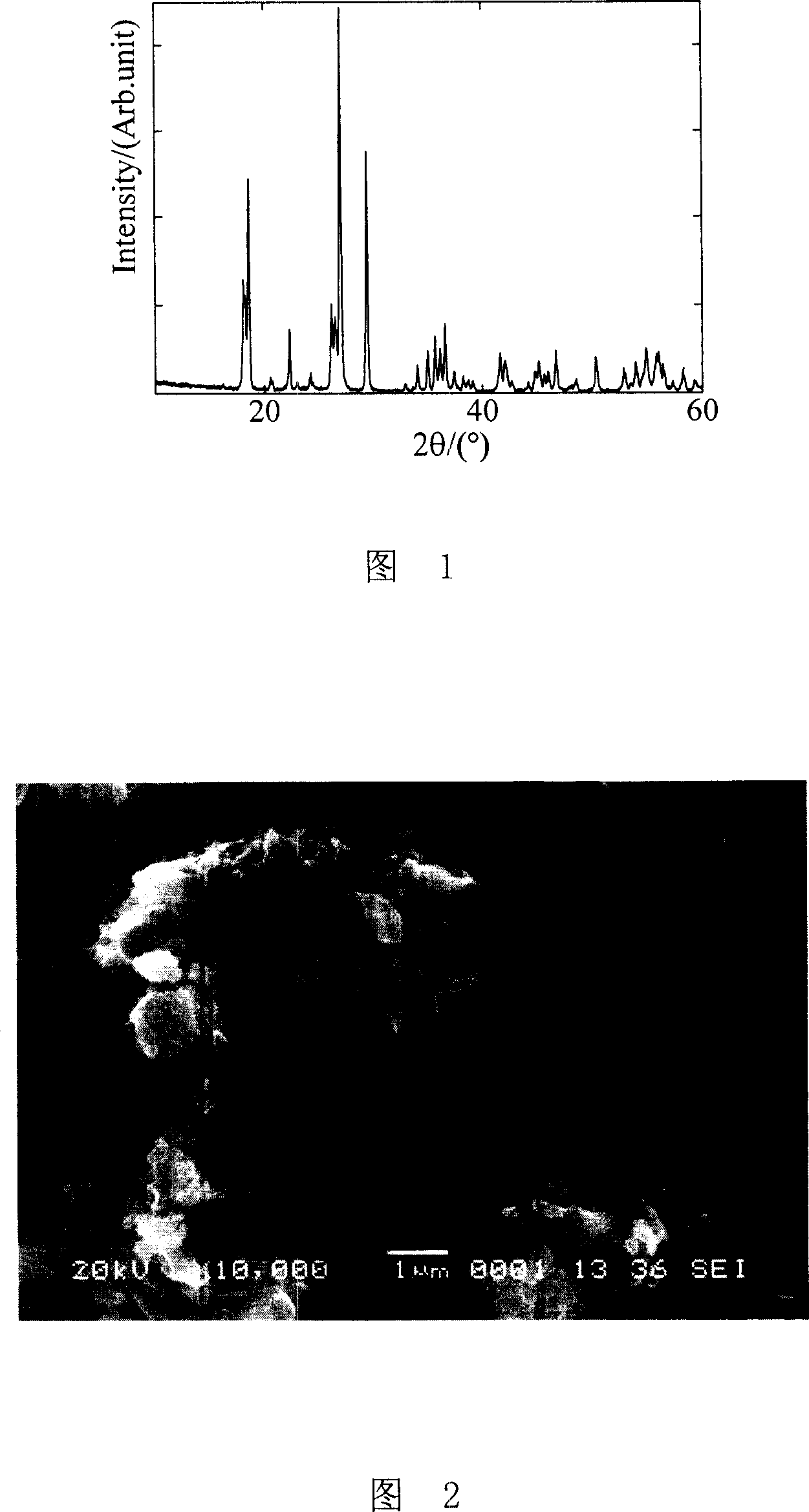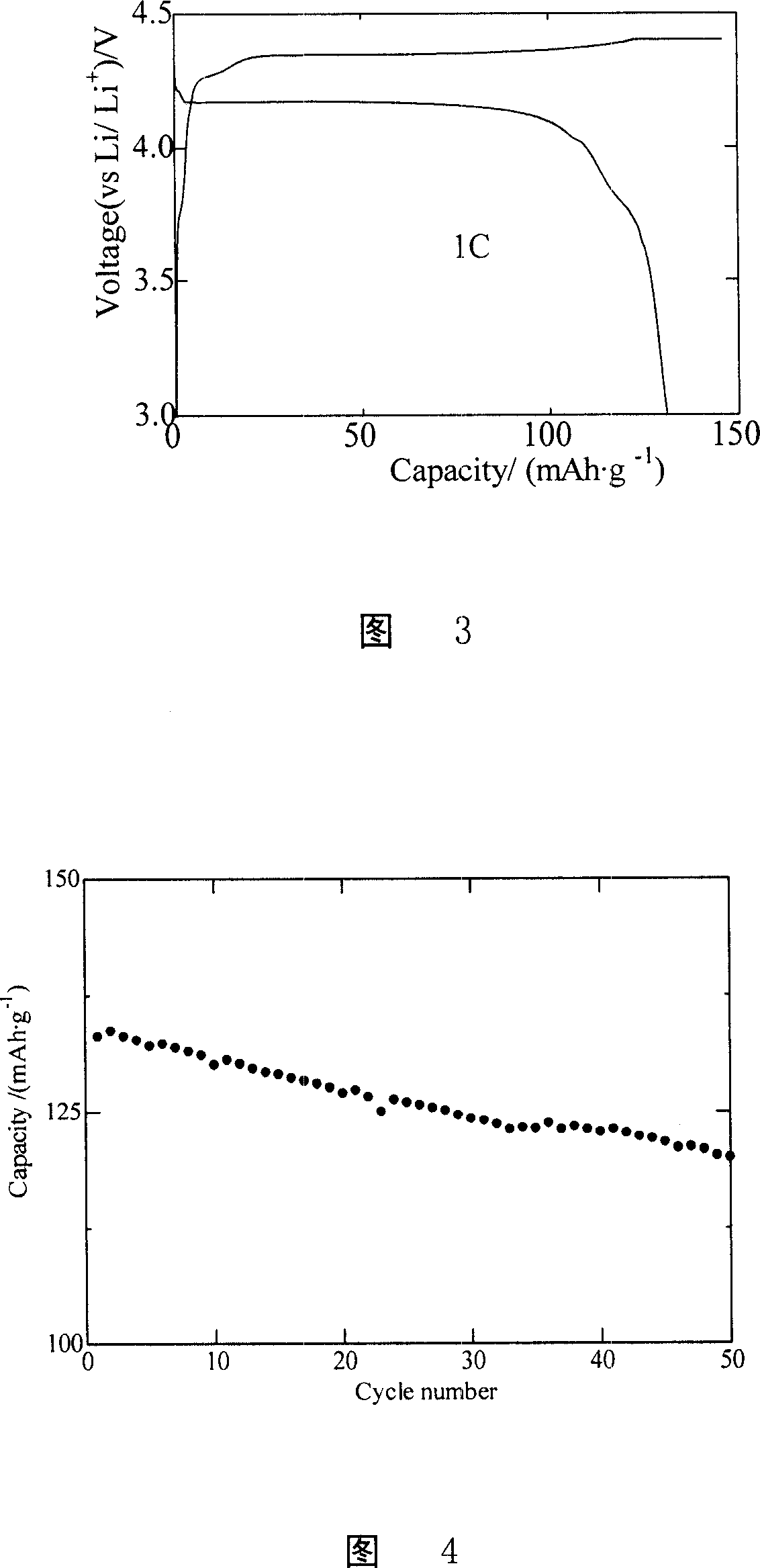Synthesizing lithium ion cell positive material fluorophosphoric vanadium-lithium by sol-gel method
A technology of lithium-ion batteries and lithium vanadium phosphate, applied in battery electrodes, electrode manufacturing, circuits, etc., can solve the problems of uneven particle size distribution of synthetic materials, unfavorable industrial production, and low electrical conductivity, and achieve lower calcination temperature, The effect of shortening the synthesis cycle and uniform particle size distribution
- Summary
- Abstract
- Description
- Claims
- Application Information
AI Technical Summary
Problems solved by technology
Method used
Image
Examples
Embodiment 1
[0020] Fully dissolve 0.1mol vanadium pentoxide, 0.2mol ammonium dihydrogen phosphate, 0.2mol lithium hydroxide, 0.2mol ammonium fluoride, and 0.4mol oxalic acid, then stir and mix, then add 0.05-0.2mol sodium hydroxide to control the pH value 8. React in a stirred reactor at 40°C for 4 hours to form a gel. Send the gel sample into a vacuum drying oven for further drying at 100°C for 10 hours to obtain a dry gel. After completion, send the mixture into a tube furnace with temperature control, and heat it at 200°C for 3 hours to decompose the organic matter, and then cool it naturally with the furnace. Remove the sample and grind it carefully. Then the samples were sent to a tube furnace, and samples No. 1, 2, 3, and 4 were calcined at 450°C, 550°C, 650°C, and 750°C for 10 hours under the protection of an inert gas. The resulting No. 3 sample product was analyzed by X-ray diffraction, showing that it was all LiVPO 4 F, without any impurity phase, the particle size of the prod...
Embodiment 2
[0024] After fully stirring and mixing 0.2mol ammonium metavanadate, 0.2mol triammonium phosphate, 0.2mol lithium hydroxide, 0.2mol ammonium fluoride, and 0.4mol citric acid, add 0.05-0.2mol sodium hydroxide to control the pH value to 8. React in a stirred reactor at 50°C for 3h to form a gel. Send the gel sample into a vacuum drying oven for further drying at 120°C for 8 hours to obtain a dry gel. After completion, send the mixture into a tube furnace with temperature program control, and pretreat it at 300°C for 2 hours to decompose the organic matter, and cool it naturally with the furnace , take out the sample and grind it carefully. Then samples Nos. 1, 2, 3, and 4 were sent into a tube furnace, heated to 650° C. under the protection of an inert gas, and calcined for 5, 10, 15, and 20 hours, respectively. The resulting product was analyzed by X-ray diffraction, showing that they were all LiVPO 4 F, without any impurity phase, the particle size of the product obtained by...
Embodiment 3
[0027] Example 3 Mix 0.2mol lithium fluoride, 0.2mol ammonium metavanadate, 0.2mol ammonium dihydrogen phosphate, and 0.4mol citric acid, and stir evenly, adjust the pH value to 8, and react in a stirred reactor at 60°C 2h to form a gel. Send the gel sample into a vacuum drying oven for further drying at 150°C for 6 hours to obtain a dry gel. After completion, send the mixture into a tube furnace with temperature control, and pretreat it at 400°C for 1 hour to decompose the organic matter, and cool it naturally with the furnace , take out the sample and grind it carefully. Then samples Nos. 1, 2, 3, and 4 were sent into a tube furnace, heated to 400°C under the protection of an inert gas, and calcined for 5, 10, 15, and 20 hours, respectively. The resulting product was analyzed by X-ray diffraction, showing that they were all LiVPO 4 F, without any impurity phase, the particle size of the product obtained by SEM is about 100nm. The obtained product was assembled into an exp...
PUM
 Login to View More
Login to View More Abstract
Description
Claims
Application Information
 Login to View More
Login to View More - R&D
- Intellectual Property
- Life Sciences
- Materials
- Tech Scout
- Unparalleled Data Quality
- Higher Quality Content
- 60% Fewer Hallucinations
Browse by: Latest US Patents, China's latest patents, Technical Efficacy Thesaurus, Application Domain, Technology Topic, Popular Technical Reports.
© 2025 PatSnap. All rights reserved.Legal|Privacy policy|Modern Slavery Act Transparency Statement|Sitemap|About US| Contact US: help@patsnap.com


